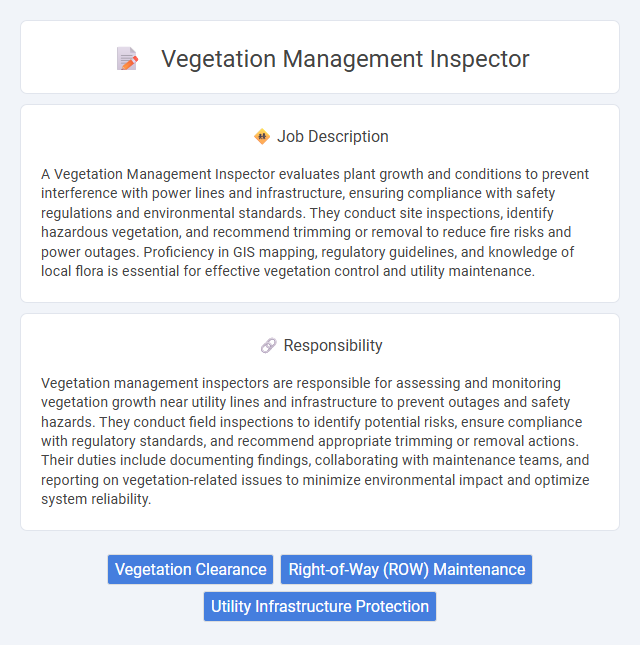
A Vegetation Management Inspector evaluates plant growth and conditions to prevent interference with power lines and infrastructure, ensuring compliance with safety regulations and environmental standards. They conduct site inspections, identify hazardous vegetation, and recommend trimming or removal to reduce fire risks and power outages. Proficiency in GIS mapping, regulatory guidelines, and knowledge of local flora is essential for effective vegetation control and utility maintenance.
Vegetation management inspectors are likely to be suited for this job if they possess strong attention to detail and physical endurance, as the role often requires inspecting outdoor environments in various weather conditions. Candidates with a background in environmental science or forestry and good communication skills probably have an advantage in effectively assessing vegetation risks and reporting findings. Individuals prone to discomfort in outdoor settings or those lacking patience for systematic inspections might find this job less suitable.
Qualification
A Vegetation Management Inspector must possess a strong understanding of plant biology, ecology, and environmental regulations to ensure safe and effective maintenance around utility infrastructure. Relevant qualifications include a bachelor's degree in environmental science, forestry, or a related field, coupled with experience in vegetation control and risk assessment. Certification in arboriculture or utility vegetation management enhances expertise and compliance with industry standards.
Responsibility
Vegetation management inspectors are responsible for assessing and monitoring vegetation growth near utility lines and infrastructure to prevent outages and safety hazards. They conduct field inspections to identify potential risks, ensure compliance with regulatory standards, and recommend appropriate trimming or removal actions. Their duties include documenting findings, collaborating with maintenance teams, and reporting on vegetation-related issues to minimize environmental impact and optimize system reliability.
Benefit
Vegetation management inspectors likely enhance safety by preventing interference with power lines and infrastructure, reducing power outages and fire risks. Their role probably supports environmental sustainability through proper plant maintenance and control, promoting ecosystem health. Benefits may also include opportunities for fieldwork, contributing to diverse job experiences and skill development.
Challenge
Vegetation management inspectors likely face the challenge of accurately assessing diverse and rapidly changing environments to prevent potential hazards such as power line interference and wildfires. The role probably demands strong analytical skills and attention to detail to identify areas that require intervention while adhering to safety and environmental regulations. Balancing fieldwork with regulatory compliance may present ongoing difficulties that require adaptive problem-solving and effective communication.
Career Advancement
Vegetation management inspectors play a critical role in ensuring the safety and reliability of utility infrastructures by identifying and mitigating vegetation-related risks. Career advancement opportunities in this field typically include progression to senior inspection roles, supervisory positions, or specialized roles such as environmental compliance or vegetation management planning. Gaining certifications such as Certified Arborist or utility-specific training can accelerate promotion pathways and enhance expertise in regulatory compliance and risk assessment.
Key Terms
Vegetation Clearance
Vegetation management inspectors specialize in overseeing vegetation clearance to ensure compliance with environmental regulations and safety standards. They conduct detailed site assessments, identify potential hazards related to overgrown vegetation near utilities and infrastructure, and enforce clearance requirements to prevent outages and fire risks. Their expertise supports the sustainable management of natural landscapes while safeguarding critical assets.
Right-of-Way (ROW) Maintenance
Vegetation management inspectors specializing in Right-of-Way (ROW) maintenance ensure that trees, shrubs, and other plant growth do not interfere with power lines, pipelines, or transportation infrastructure, mitigating risks of outages and accidents. They conduct thorough inspections, assess vegetation hazards, and coordinate with maintenance crews to implement trimming, removal, or herbicide treatments according to regulatory and safety standards. Proficiency in GIS mapping, knowledge of environmental regulations, and understanding of utility corridor requirements are critical for effective ROW vegetation management.
Utility Infrastructure Protection
Vegetation management inspectors play a critical role in Utility Infrastructure Protection by assessing and controlling plant growth around power lines, substations, and pipelines to prevent service disruptions and safety hazards. Their inspections ensure compliance with regulatory standards and identify potential risks such as tree encroachments and invasive species that could damage equipment or cause outages. Effective management reduces wildfire risks, improves reliability, and supports the longevity of essential utility assets.
 kuljobs.com
kuljobs.com